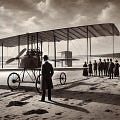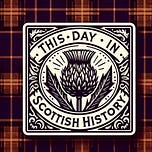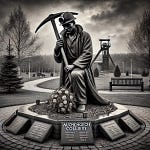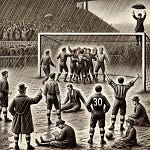Welcome back to This Day in Scottish History. I'm your host, Colin MacDonald, and today we’re traveling back to September 17, 1910, to celebrate one of Scotland’s lesser-known pioneers: Andrew Blain Baird. On this day, Baird made the first powered monoplane flight in Scotland at Ettrick Bay on the Isle of Bute in a self-built aircraft. Baird’s story is a fascinating tale of Scottish ingenuity and determination, and today we’re going to explore his life, his aircraft, and the legacy of his historic flight.
Andrew Blain Baird was born on January 1, 1862, in Sandhead, a small village on Luce Bay in Galloway. He was one of three sons, and like many in rural Scotland, his early life was shaped by traditional trades. His father was a fisherman and handloom weaver, and Baird’s journey began in a blacksmith’s workshop, where he apprenticed as a young man. But Baird’s ambitions were far larger than the forge.
Throughout his life, he worked in various roles—he was a lighthouse keeper on Lismore Island and later an ironworker in the Clyde shipyards. In 1887, he finally settled on the Isle of Bute, where he opened his own blacksmith business at the age of 25. However, Baird wasn’t content with just mastering one trade; he was a natural innovator. He developed improvements for agricultural tools, designed machinery, and by the early 1900s, he became fascinated with the world of aviation.
Baird’s passion for aviation was sparked at a time when powered flight was still in its infancy. In 1909, he attended Britain’s first aviation event in Blackpool, where pioneers like Louis Blériot and S.F. Cody were showcasing their early aircraft. Baird, inspired by what he saw, returned to his workshop in Rothesay determined to build his own flying machine.
Baird’s monoplane, which he completed in 1910, was a marvel of craftsmanship. Modeled after Blériot’s design, it featured a 4-cylinder engine built by the Alexander Brothers in Edinburgh, and the wings were made from silk sewn by his wife, Euphemia. This was no small project—it required precision engineering and a deep understanding of aerodynamics. Remarkably, Baird did much of this work in his blacksmith shop, proving that with ingenuity and determination, one could build a plane anywhere, even in a small town on the Isle of Bute.
The morning of September 17, 1910, was a landmark moment for Scottish aviation. Andrew Blain Baird and his team, including his friend Ned Striven, an electrical engineer, transported the monoplane to Ettrick Bay, a long, flat beach perfect for attempting a flight. The wide, open space of the beach was reminiscent of Kitty Hawk, where the Wright Brothers had made history just seven years earlier.
With anticipation running high, Baird took his seat in the pilot’s chair, and the engine roared to life. As the plane sped across the sand, it lifted briefly off the ground. But after a few exhilarating seconds, the monoplane swerved to the right and crash-landed back onto the beach. While the flight lasted only a few moments and ended in damage to one of the wheels and wings, it was still a significant achievement: it was the first attempt at a powered flight on Scottish soil.
Although the flight didn’t go as planned, Andrew Baird had realized his dream—if only for a few fleeting seconds. His achievement was groundbreaking, and his monoplane remains a symbol of Scottish innovation. While the plane itself has been lost to history, the engine was preserved and eventually donated to the Museum of Transport in Glasgow, where it stands as a reminder of Baird’s bold venture into aviation.
In 2010, to mark the centenary of Baird’s historic flight, the Baird of Bute Society was established. The society organizes annual celebrations on the Isle of Bute, including a fly-in at the newly renamed Andrew Baird Airstrip and ceremonial flyovers at Ettrick Bay. This celebration not only honours Baird’s contribution to aviation but also serves as an inspiration for future generations.
The Baird of Bute Society has a broader mission beyond just commemorating a historical event. Its core purpose is to inspire young people across Scotland to aspire to great things, just as Andrew Blain Baird did over a century ago. The society offers scholarships, mentorship programs, and awards that encourage youth to pursue entrepreneurial and academic goals, promoting innovation and creativity.
Baird’s story is not just one of a singular event; it’s a legacy that continues to influence Scotland today. His determination to build a flying machine with the limited resources he had is a testament to the Scottish spirit of perseverance, creativity, and ambition.
As we look back on this day in 1910, we celebrate the life and legacy of Andrew Blain Baird, the "Flying Blacksmith" of Bute. His dream of flight, grounded in hard work and innovative thinking, took to the skies—if only for a moment—and laid the groundwork for Scottish aviation.
Thank you for joining me on This Day in Scottish History. I’m Colin MacDonald, and I hope you’ll tune in next time as we uncover more remarkable moments from Scotland’s rich past. Haste Ye Back!












September 17, 1910 - First Powered Monoplane Flight in Scotland